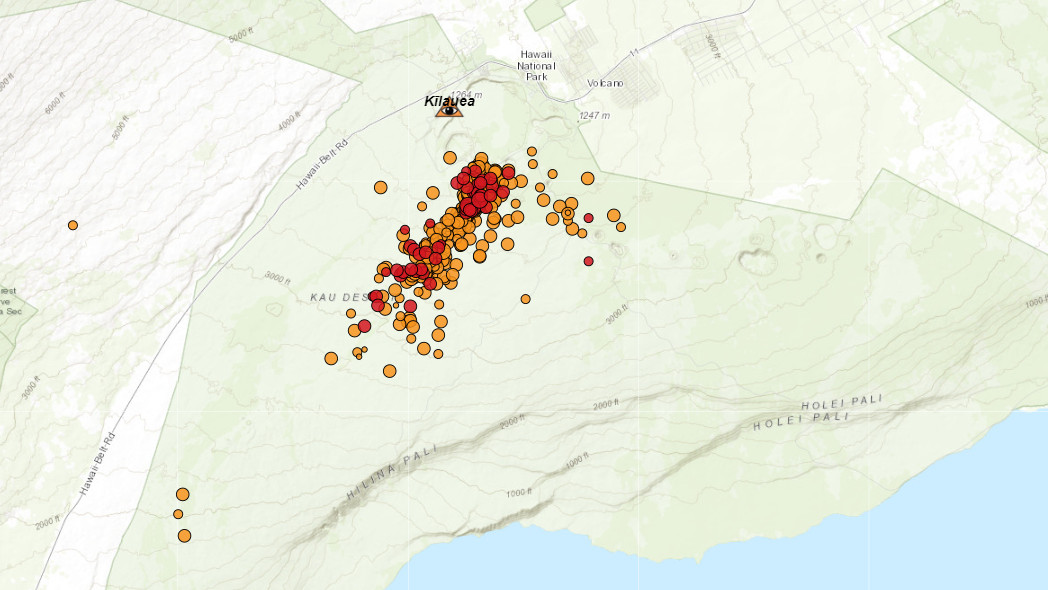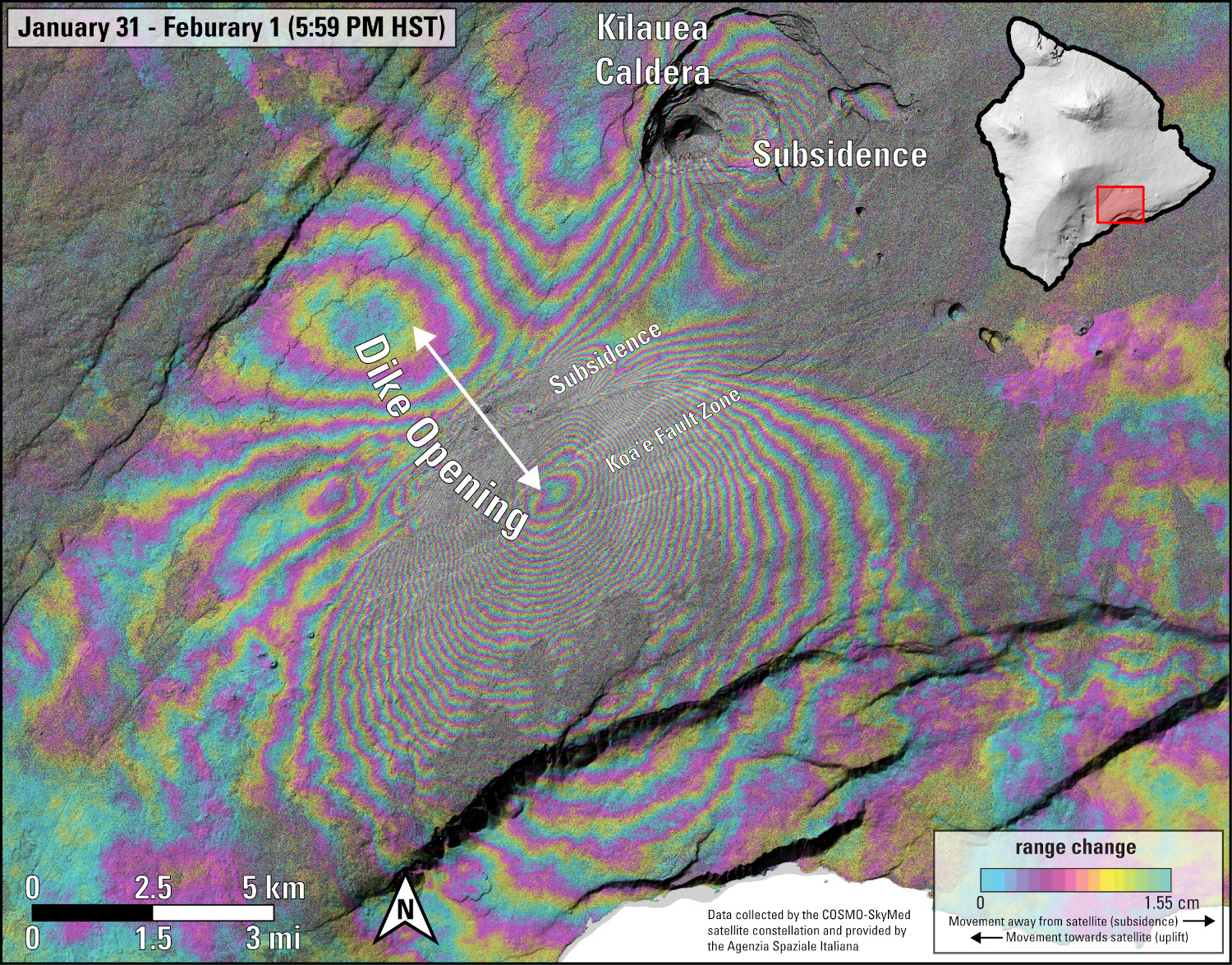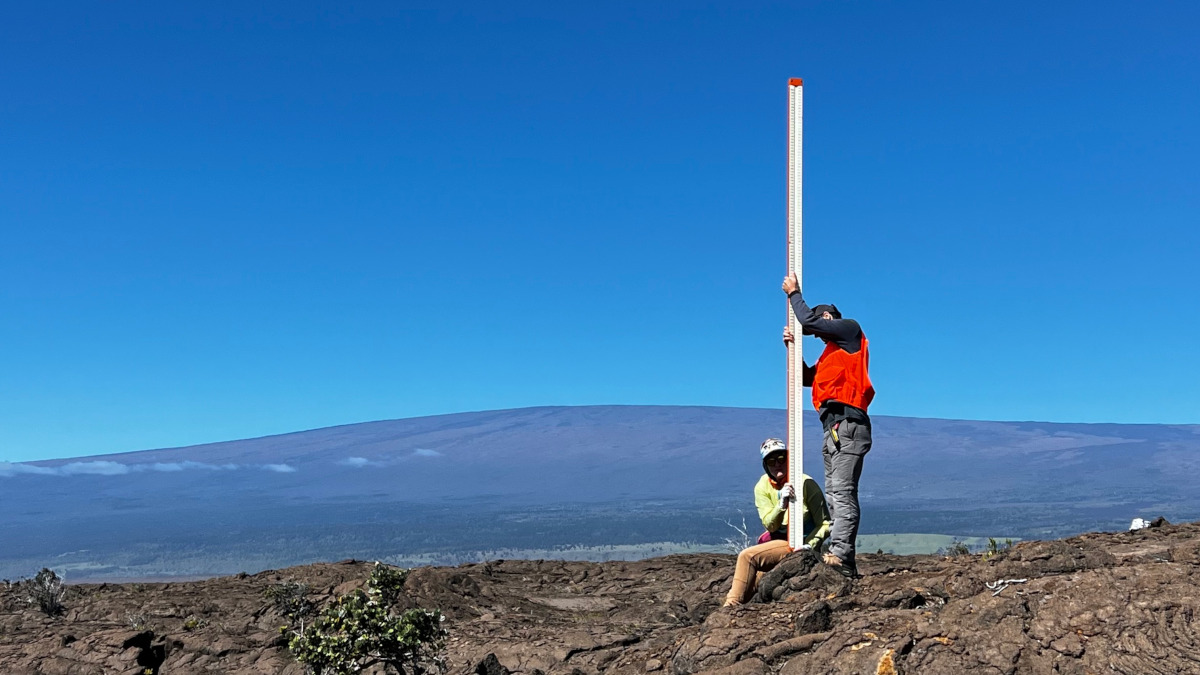(BIVN) – Kīlauea is not erupting, and its USGS Volcano Alert level is ADVISORY.
The Hawaiʻi island volcano has been fairly queit since the dramatic magma intrusion in early February that did not result in an eruption.
This week’s Volcano Watch article, written by HVO geophysicist Ingrid Johanson, explains why the intrusion was a classic example of a volcanic dike propagation.
From January 31 to February 3, 2024, a magma intrusion into Kīlauea’s flank, southwest of the summit caldera, was the focus of attention at the USGS Hawaiian Volcano Observatory (HVO).

image from interactive USGS map showing the location of the latest earthquake activity south of the Kīlauea caldera on January 31st.
Hundreds of earthquakes announced the influx of new magma. The intensity of the seismic activity was similar to what has preceded recent summit eruptions at Kīlauea, prompting HVO staff to raise Kīlauea’s Alert Level/Aviation Color Code to WATCH/ORANGE at 4:41 a.m. HST on January 31. After earthquake activity receded on February 3, 2024, the alert level was returned to ADVISORY/YELLOW.
In addition to the high number of earthquakes, high rates of deformation were also recorded during the intrusion. Typically, HVO monitors near real-time changes in deformation using a network of tiltmeters and continuous GPS stations. For this intrusion, lucky timing of image acquisitions from the Italian Space Agency’s COSMO-SkyMed satellite (CSM), gave us a special 1-day image pair from 6 p.m. HST on January 31 through 6 p.m. HST on February 1. Differences between the image pair show how the ground deformed over that 24-hour period, in what is called an interferogram.
This interferogram confirmed that the recent intrusion was larger than previous ones in October 2023 or August 2021. The pattern of deformation in the interferogram had a “classic” dike-opening intrusion pattern; what we would expect from magma opening a rectangular, vertically oriented space in the existing rock.

USGS: “This image shows ground deformation during the recent intrusive activity at Kīlauea volcano. Unlike previous shared interferograms, note that this one is isolated to a one-day timeframe from January 31-February 1, 2024. It therefore highlights the volcanic signals, with reduced interference from sources of data noise. Colored fringes denote areas of ground deformation, with more fringes indicating more deformation. Each color cycle represents 1.5 cm (0.6 in) of ground motion toward or away from the satellite (the direction of motion depends on the sense of color change). The complex patterns indicate overall deflation of the summit area as magma moved underground to the southwest, where the patterns show uplift and spreading (along with localized subsidence). Data are from the COSMO-SlyMed constellation of radar satellites, provided by the Italian Space Agency (Agenzia Spaziale Italiana) through the Hawaiʻi Supersite.”
The shape of the opening magma body affects what the pattern of ground deformation will be. For example, a spherical magma chamber will cause outward motion and uplift when it inflates. The deformation pattern from dike-opening is complicated and consists of outward and upward motion away from the broad sides of the dike. At the same time, the ground just outside the dike tip is pulled towards the dike and the ground just above is pulled downwards. This is not that different from opening a bag of chips by pulling on the sides. As you’re pulling the sides outwards, the top and side edge of the packet get drawn down and inwards.
Seeing a dike-opening pattern in an interferogram is made even more complicated by how interferograms record ground motion. The fringes (one rainbow cycle) in an interferogram represent motion between the ground and satellite (range change) in the “look direction” of the radar instrument. For CSM, one fringe equals 1.5 cm (0.6 in) of range change. The satellites we use do not look straight down at the ground, instead they send the radar pulses out at an angle (CSM’s look angle is about 40 degrees off-vertical). This means that both horizontal and vertical motion get mixed together to create “range change.”
In the Jan. 31–Feb. 1 interferogram, outward and upward motion to the southeast add together to create dense fringes. However, outward motion and upward motion to the northwest cancel each other out somewhat and result in fewer fringes. This is because motion to the northwest increases range change, but upward motion decreases it.
If one looks carefully, the fringes to the southeast progress from pink to yellow to blue, as you proceed away from the central “bullseye.” The fringes on the northwest side progress from blue to yellow to pink away from the bullseye in that area. This means that range change is increasing in that quadrant; because there was so much horizontal motion away from the satellite, it completely counteracted the uplift to create lengthening range change.
In between the colorful lobes to the southeast and northwest, there is an area of dense and discontinuous fringes in the middle. This is the portion of ground that subsided above the dike. It’s also an area with lots of surface cracks, which is why there is sometimes a sharp offset in the fringe patterns.
To a geophysicist, this is a beautiful interferogram. Not just because of the interesting patterns of the rainbow fringes, but because it beautifully illustrates the unique way that interferograms capture ground motion via range change. It’s also a textbook illustration of deformation from a dike intrusion, one of the fundamental processes for magma migration at volcanoes around the world.


by Big Island Video News7:53 am
on at
STORY SUMMARY
HAWAIʻI VOLCANOES NATIONAL PARK - Scientists say the recent intrusion was larger than previous ones in October 2023 or August 2021.